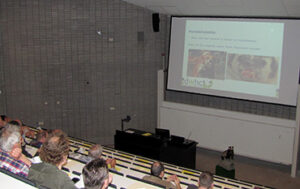Minutes of the badger meeting 5th April 2014
DWHC Badger post-mortem investigation 2013
- In 2013 more than 60 badgers were submitted; the majority had been killed on the roads as seen by evidence of extensive trauma in these cadavers. Several infectious diseases including Morbillivirus sp.infection and a skin yeast infection caused by Malassezia sp. were found. In addition the lung disease pneumoconiosis was frequently observed.
- A single animal tested positive for Morbillivirus sp. infection; the family of viruses that cause canine distemper, human measles and seal distemper. There are previous reports of canine distemper being found in badgers in which it has been associated with death. Dogs are typically vaccinated against this pathogen which is, as a result, rarely seen in dogs. Signs of distemper virus infection can include a nasal and ocular discharge, breathing difficulties and in some chronic cases thickened foot pads and nose.
- In a single animal Malassezia sp. yeast was found in a skin ulcer. In dogs, several types of Malassezia can be found in the skin and ears of clinically normal animals; it is unknown as to why in some cases this can lead to inflammation of the skin. The situation in badgers with regard to whether Malassezia can also be found in the skin of clinically normal animals, and if so which sorts and whether they are associated with skin disease is not clear. This single case may have been an incidental finding.
- Pneumoconiosis was seen in approximately 90% of the sampled badgers. This disease develops when animals inhale dust and particles; in this case it is unknown as to whether the dust seen in the lungs of badgers is derived from the ground (e.g. during digging activities) or from the air, and further what sort of dust it is.
In addition to investigating the cause of death and surveying general health status on post-mortem exam, submitted badgers were also tested for the presence of bacteria belonging to the Mycobacterium tuberculosis complex. To date there is no evidence that this pathogen is present in badgers in the Netherlands.





